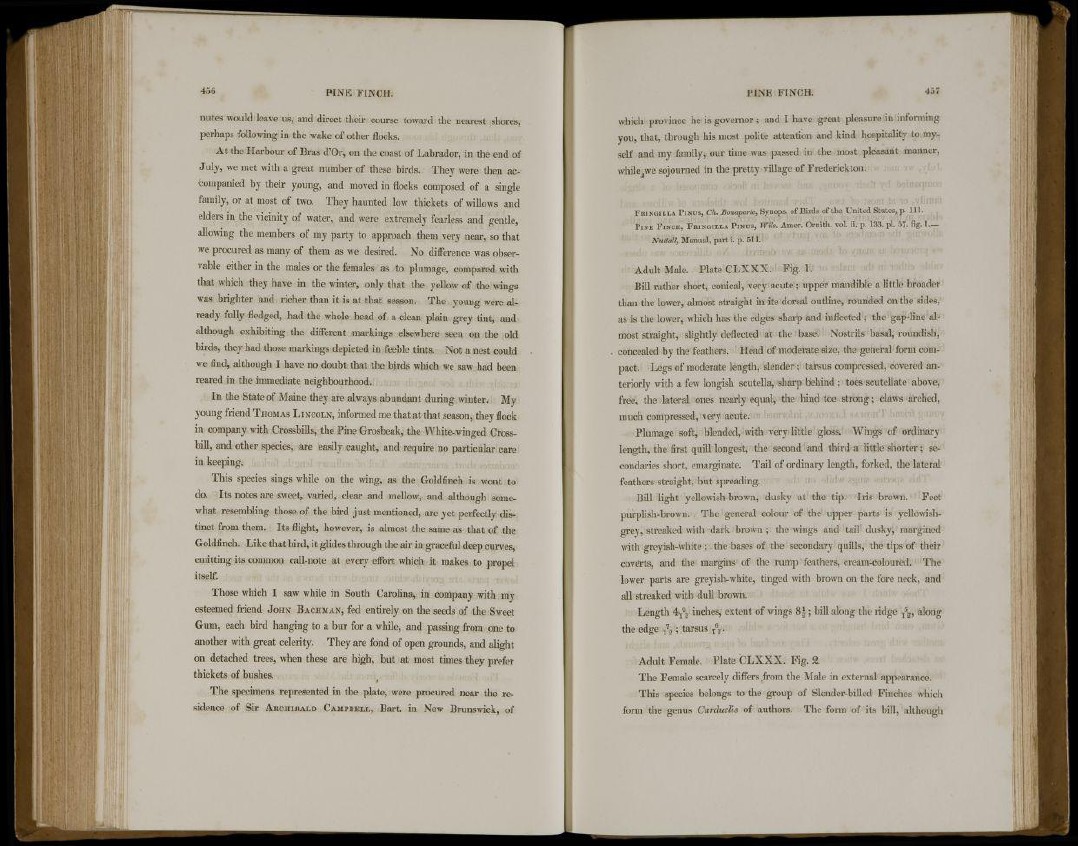
456 P I N E FINCH.
nutes would leave us, and direct their course toward the nearest shores,
perhaps following in the wake of other flocks.
At the Harbour of Bras d'Or, on the coast of Labrador, in the end of
July, we met with a great number of these birds. They were then ac-
/companied by their young, and moved in flocks composed of a single
family, or at most of two. They haunted low thickets of willows and
elders in the vicinity of water, and were extremely fearless and gentle,
allowing the members of my party to approach them very near, so that
we procured as many of them as we desired. No difference was observable
either in the males or the females as to plumage, compared with
that which they have in the winter, only that the yellow of the wings
was brighter and richer than it is at that season. The young were already
fully fledged, had the whole head of a clean plain grey tint, and
although exhibiting the different markings elsewhere seen on the old
birds, they had those markings depicted in feeble tints. Not a nest could
we And, although I have no doubt that the birds which we saw had been
reared in the immediate neighbourhood.
In the State of Maine they are always abundant during winter. My
young friend THOMAS LINCOLN, informed me that at that season, they flock
in company with Crossbills, the Pine Grosbeak, the White-winged Crossbill,
and other species, are easily caught, and require no particular care
in keeping.
This species sings while on the wing, as the Goldfinch is wont to
do. Its notes are sweet, varied, clear and mellow, and although somewhat
resembling those of the bird just mentioned, are yet perfectly distinct
from them. Its flight, however, is almost the same as that of the
Goldfinch. Like that bird, it glides through the air in graceful deep curves,
emitting its common call-note at every effort which it makes to propel
itself.
Those which I saw while in South Carolina, in company with my
esteemed friend JOHN BACHMAN, fed entirely on the seeds of the Sweet
Gum, each bird hanging to a bur for a while, and passing from one to
another with great celerity. They are fond of open grounds, and alight
on detached trees, when these are high, but at most times they prefer
thickets of bushes.
The specimens represented in the plate, were procured near the residence
of Sir ARCHIBALD CAMPBELL, Bart, in New Brunswick, of
P I N E FINCH. 457
which province he is governor ; and I have great pleasure in informing
you, that, through his most polite attention and kind hospitality to myself
and my family, our time was passed in the most pleasant manner,
whilejwe sojourned in the pretty village of Frederickton.
FUINGILLA PINUS, CJu Bonaparte, Synops. of Birds of the United States, p. 111.
PIN* FINCH, FRINGILLA PINUS, Wits. Arner. Ornith. vol. ii. p. 133. pi. 57- fig. 1 —
Nuttall, Manual, parti, p. 511.
Adult Male. Plate CLXXX. Fig. 1.
Bill rather short, conical, very acute; upper mandible a little broader
than the lower, almost straight in its dorsal outline, rounded on the sides,
as is the lower, which has the edges sharp and inflected; the gap-line almost
straight, slightly deflected at the base. Nostrils basal, roundish,
concealed by the feathers. Head of moderate size, the general form compact.
Legs of moderate length, slender ; tarsus compressed, covered anteriorly
with a few longish scutella, sharp behind ; toes scutellate above,
free, the lateral ones nearly equal, the hind toe strong; claws arched,
much compressed, very acute.
Plumage soft, blended, with very little gloss. Wings of ordinary
length, the first quill longest, the second and third a little shorter; secondaries
short, emarginate. Tail of ordinary length, forked, the lateral
feathers straight, but spreading.
Bill light yellowish-brown, dusky at the tip. Iris brown. Feet
purplish-brown. The general colour of the upper parts is yellowishgrey,
streaked with dark brown ; the wings and tail dusky, margined
with greyish-white ; the bases of the secondary quills, the tips of their
coveTts, and the margins of the rump feathers, cream-coloured. The
lower parts are greyish-white, tinged with brown on the fore neck, and
all streaked with dull brown.
Length 4T
9
2 inches, extent of wings 8 | ; bill along the ridge T
5
2 , along
the edge 'jty ; tarsus T°j.
Adult Female. Plate CLXXX. Fig. 2.
The Female scarcely differs from the Male in external appearance.
This species belongs to the group of Slender-billed Finches which
form the genus Carduelis of authors. The form of its bill, although